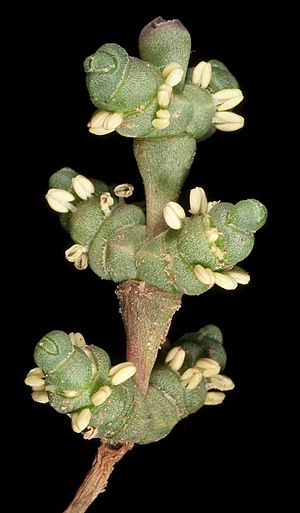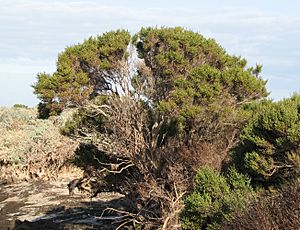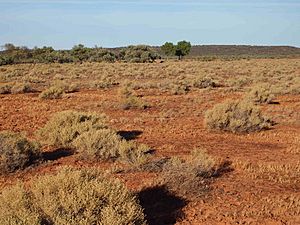Tecticornia facts for kids
Quick facts for kids Tecticornia |
|
|---|---|
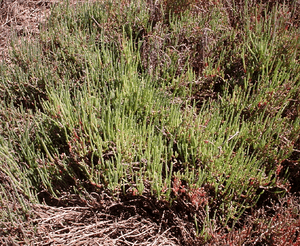 |
|
| Samphire, Tecticornia pergranulata | |
| Scientific classification |
|
| Kingdom: | Plantae |
| Clade: | Tracheophytes |
| Clade: | Angiosperms |
| Clade: | Eudicots |
| Order: | Caryophyllales |
| Family: | Amaranthaceae |
| Subfamily: | Salicornioideae |
| Genus: | Tecticornia Hook. f. |
| Species | |
|
ca. 44 species, see text |
|
Tecticornia is a group of special plants often called samphires. These plants are succulent, meaning they have thick, fleshy parts that store water. They are also salt tolerant, which means they can grow in salty places. Most Tecticornia plants are found only in Australia. In 2007, several other plant groups like Halosarcia became part of the Tecticornia family.
Contents
What They Look Like
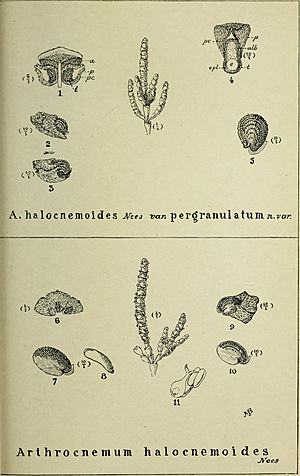
Tecticornia plants can be small herbs that live for one year or many years. They can also be small shrubs. Their stems have many branches and look like they have joints.
The leaves grow in pairs opposite each other. They are fleshy and smooth. The lower parts of the leaves join together, forming a cup or collar around the stem. The actual leaf blades are tiny, usually 0–3 mm long. They can be two-lobed or shaped like a triangle.
Flowers and Seeds
The flowers grow in spike shapes. They have special leaves called bracts that are often joined together. Inside each bract, there are usually three to five flowers. Sometimes there is only one or even seven flowers.
These flowers are usually hermaphrodite, meaning they have both male and female parts. Each flower has a small outer layer called a perianth, which has 2-3 lobes. They also have one stamen (the male part) and an ovary with two stigmas (the female parts).
When the plant makes fruit, the perianth changes. It can become thin, spongy, or hard. The fruit wall can also be thin, fleshy, or woody. The seeds are flat or wedge-shaped. Their outer layer can be smooth, bumpy, or have lines. Inside the seed, there is a curved embryo and lots of food tissue for the new plant.
Where They Grow
Almost all Tecticornia species live in Australia. However, one species, Tecticornia indica, grows in many other places. You can find it along the tropical coasts of the Indian Ocean. This includes places like Southeast Asia, South Asia, East Africa, Madagascar, and even the Atlantic coast of Senegal.
Plant Family History
The first time Tecticornia was officially described was in 1880 by Joseph Dalton Hooker. The main example species for this group was Tecticornia cinerea. This plant is now known by another name, Tecticornia australasica.
For a long time, Tecticornia was a small group with only three species. But in 2007, scientists decided to include other groups of plants. These included Halosarcia, Pachycornia, Sclerostegia, and Tegicornia. This change made Tecticornia a much larger group.
Scientists have studied how these plants are related. They found that Tecticornia and its new additions are closely related to other plant groups like Sarcocornia and Salicornia.
By 2016, there were about 44 different species of Tecticornia. Eleven of these species were discovered and named recently. Most of them are found in different parts of Australia.
Some Examples of Tecticornia Species
- Tecticornia arbuscula (Shrubby Glasswort): This plant is found in many parts of Australia, including Western Australia, South Australia, New South Wales, Victoria, and Tasmania.
- Tecticornia bulbosa (Large-articled Samphire): This plant grows inland in Western Australia. It is considered vulnerable to extinction, meaning it's at risk of disappearing forever.
- Tecticornia flabelliformis (Bead Samphire): This woody plant grows up to 20 centimetres tall. It lives in salty areas near salt lakes. It is also listed as vulnerable to extinction in Australia.
- Tecticornia halocnemoides (Shrubby Samphire): This species is very common across Australia.
- Tecticornia indica: This species is found widely in Australia and along tropical coasts around the Indian Ocean.
- Tecticornia pergranulata (Blackseed Samphire): You can find this plant inland across much of Australia.
What They Are Used For
The young branches of Tecticornia indica can be cooked and eaten like a vegetable. In Madagascar, people pickle these branches in vinegar and use them as a spice to add flavor to food.
See also
 In Spanish: Tecticornia para niños
In Spanish: Tecticornia para niños


